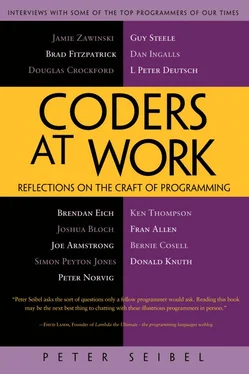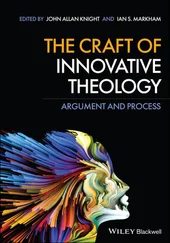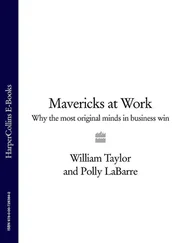Peter Seibel - Coders at Work - Reflections on the craft of programming
Здесь есть возможность читать онлайн «Peter Seibel - Coders at Work - Reflections on the craft of programming» весь текст электронной книги совершенно бесплатно (целиком полную версию без сокращений). В некоторых случаях можно слушать аудио, скачать через торрент в формате fb2 и присутствует краткое содержание. Жанр: Программирование, на английском языке. Описание произведения, (предисловие) а так же отзывы посетителей доступны на портале библиотеки ЛибКат.
- Название:Coders at Work: Reflections on the craft of programming
- Автор:
- Жанр:
- Год:неизвестен
- ISBN:нет данных
- Рейтинг книги:3 / 5. Голосов: 1
-
Избранное:Добавить в избранное
- Отзывы:
-
Ваша оценка:
- 60
- 1
- 2
- 3
- 4
- 5
Coders at Work: Reflections on the craft of programming: краткое содержание, описание и аннотация
Предлагаем к чтению аннотацию, описание, краткое содержание или предисловие (зависит от того, что написал сам автор книги «Coders at Work: Reflections on the craft of programming»). Если вы не нашли необходимую информацию о книге — напишите в комментариях, мы постараемся отыскать её.
Coders at Work
Founders at Work
Coders at Work: Reflections on the craft of programming — читать онлайн бесплатно полную книгу (весь текст) целиком
Ниже представлен текст книги, разбитый по страницам. Система сохранения места последней прочитанной страницы, позволяет с удобством читать онлайн бесплатно книгу «Coders at Work: Reflections on the craft of programming», без необходимости каждый раз заново искать на чём Вы остановились. Поставьте закладку, и сможете в любой момент перейти на страницу, на которой закончили чтение.
Интервал:
Закладка:
Seibel:So they were bugs in the algorithm which the proof missed since the result of the proof was, Q.E.D. this thing works.
Steele:Yes, the proof presented was a faulty proof. Because something had been overlooked somewhere. It was some detail of formula manipulation—the formula was almost right but not quite. And I think it was a matter of correcting the order—the sequence of two statements or something.
Seibel:So it took you 25 hours to analyze the proof. Could you have found the bug in the code in just 25 hours if you just had the code?
Steele:I doubt I would have even realized there was a bug. The algorithm was sufficiently intricate that I would probably have stared at the code and said, “Yeah, this makes sense to me” and not have spotted this very obscure interaction. It was a multistep sequence that was necessary—a highly unlikely interaction.
Seibel:And so that kind of interaction basically gets abstracted by the process of making the proof so you don’t have to come up with this scenario of what if this happens and then this and then this to realize that there’s a problem.
Steele:Exactly. In effect the proof takes the global point of view and covers all the possibilities, summarizing it in a very complicated formula. And you have to do formula crunching to push it through. So the author resubmitted the paper and it came back for rereviewing and even though I had done the entire exercise, it took me another 25 hours to reverify the proof. This time it all seemed to be sound.
I reported that and the paper was published and nobody’s found a bug in it since. Is it actually bug-free? I don’t know. But I think having gone through the exercise of the proof gives me a lot more confidence that the algorithm is now sound. And I’m hoping that I wasn’t the only reviewer who actually did the complete cranking through of the proof.
Seibel:There’s a Dijkstra quote about how you can’t prove by testing that a program is bug-free, you can only prove that you failed to find any bugs with your tests. But it sort of sounds the same way with a proof—you can’t prove a program is bug-free with a proof—you can only prove that, as far as you understand your own proof, it hasn’t turned up any bugs.
Steele:That’s true. Which is why there is a subspecialty in the discipline having to do with mechanical proof verification. And the hope is that you then reduce the problem to proving that the proof verifier is correct. Which is—if you can write a small enough verifier—actually a much more tractable problem that verifying the proof of any rather large program.
Seibel:And then the manually proved mechanical verifier would do the 25 hours of work you did of grinding out a verification of a specific proof of some other piece of code?
Steele:Yes. Exactly.
Seibel:Is there anything that you would like to talk about?
Steele:Well, we haven’t talked that much about the beauty in programs, and I wouldn’t want that to go without remark. I have read some programs that really strike me as having a kind of beauty to them. TeX is one example, the source code for TeX. METAFONT a little less so and I don’t know whether it’s just because I use the program less or there’s something subtly different about the organization of the code or about the design of the program that I like less. I really can’t decide.
There are certain algorithms that strike me as just wonderful. I have seen little pieces of program that were marvels of code compression back in the days when that mattered—when you had only a megabyte of memory, whether you used 40 words or 30 really mattered, and people would really work hard sometimes to squeeze a program down. Bill Gosper wrote these little four-line wonders that would do amazing things if you then connected an amplifier to the low bits of some accumulator while it was twiddling the bits.
This may seem like a terrible waste of my effort, but one of the most satisfying moments in my career was when I realized that I had found a way to shave one word off an 11-word program that Gosper had written. It was at the expense of a very small amount of execution time, measured in fractions of a machine cycle, but I actually found a way to shorten his code by 1 word and it had only taken me 20 years to do it.
Seibel:So 20 years later you said, “Hey Bill, guess what?”
Steele:It wasn’t that I spent 20 years doing it, but suddenly after 20 years I came back and looked at it again and suddenly had an insight I hadn’t had before: I realized that by changing one of the op codes, it would also be a floating point constant close enough to what I wanted, so I could use the instruction both as an instruction and as a floating point constant.
Seibel:That’s straight out of “The Story of Mel, a Real Programmer.”
Steele:Yeah, exactly. It was one of those things. And, no, I wouldn’t want to do it in real life, but it was the only time I’d managed to reduce some of Gosper’s code. It felt like a real victory. And it was a beautiful piece of code. It was a recursive subroutine for computing sines and cosines.
So that’s the kind of thing we worried about back then. When I programmed on the IBM 1130, there was this concept of a boot card, which is a single card you put on the front of your deck. You hit a start button on the computer and the hardware would automatically read the first card and put it in the first 80 locations in memory. And then start execution at a given location. And the job of that card was then to be a real card-reader routine to read the rest of the cards, and then that’s how you got yourself bootstrapped.
What made it hard on the IBM 1130 was that cards have only 12 rows and it was a 16-bit computer word. So the 12 bits were scattered throughout the 16 bits of instructions, which meant that some instructions couldn’t be represented on the card. Therefore any instructions that couldn’t be represented on the card had to be built by using other instructions that were on the card. So you had this very complicated trade-off—“What instructions can I use, and if I use this instruction; I’m going to need several other instructions on the card just to build it”—and this presented a tremendous amount of pressure and you only got 80 words to write your routine, and so you do tend to use things like reusing instructions as data, using a piece of data for more than one thing. If you can manage to put this little subroutine there in memory, then its address can also be used as a data constant. This is what it took—it was origami and haiku and all that as a style of programming. And I spent several years doing that.
Seibel:Do you think that people who went through that discipline are better or worse programmers in the current environment?
Steele:They got experience at dealing with resource constraints and trying to measure them accurately.
Seibel:Well, learning to measure them accurately is a good thing. But it can also cut both ways where you develop habits of programming that are now maladaptive.
Steele:It’s easy to become too fixated on optimizing something just because you can, even though it’s not what you need to work on. That’s indeed true. I’m glad that my son had the experience of programming TI calculators when he was in high school. Because again, those had moderately severe memory constraints. And so he had to learn how to represent data in compressed forms to get it to fit in the calculator. I wouldn’t want him to spend his whole programming career that way, but I think it was a useful experience.
Читать дальшеИнтервал:
Закладка:
Похожие книги на «Coders at Work: Reflections on the craft of programming»
Представляем Вашему вниманию похожие книги на «Coders at Work: Reflections on the craft of programming» списком для выбора. Мы отобрали схожую по названию и смыслу литературу в надежде предоставить читателям больше вариантов отыскать новые, интересные, ещё непрочитанные произведения.
Обсуждение, отзывы о книге «Coders at Work: Reflections on the craft of programming» и просто собственные мнения читателей. Оставьте ваши комментарии, напишите, что Вы думаете о произведении, его смысле или главных героях. Укажите что конкретно понравилось, а что нет, и почему Вы так считаете.












